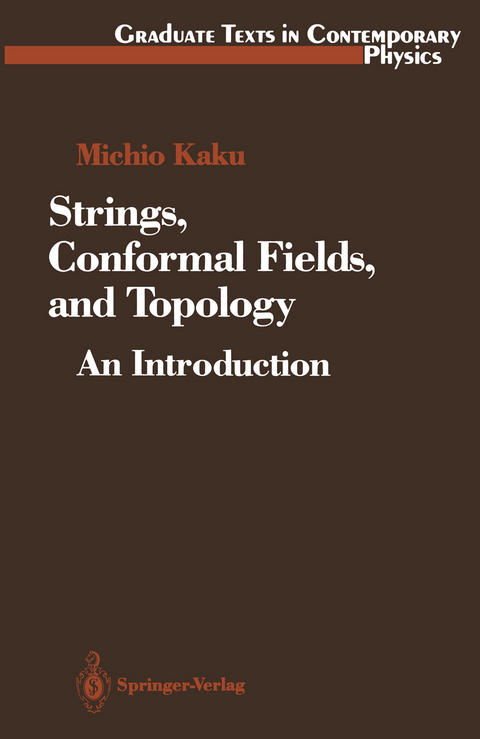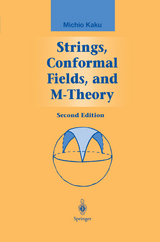
Strings, Conformal Fields, and Topology
Springer-Verlag New York Inc.
9781468403992 (ISBN)
- Titel erscheint in neuer Auflage
- Artikel merken
I Conformal Field Theory and Perturbation Theory.- 1 Introduction to Superstrings.- 1.1. Introduction.- 1.2. Quantizing the Relativistic String.- 1.3. Scattering Amplitudes.- 1.4. Supersymmetry.- 1.5. 2D SUSY versus 10D SUSY.- 1.6. Types of Strings.- 1.7. Summary.- 2 BPZ Bootstrap and Minimal Models.- 2.1. Conformal Symmetry in D Dimensions.- 2.2. Conformal Group in Two Dimensions.- 2.3. Representations of the Conformal Group.- 2.4. Fusion Rules and Correlation Functions.- 2.5. Minimal Models.- 2.6. Fusion Rules for Minimal Models.- 2.7. Superconformal Minimal Series.- 2.8. Summary.- 3 WZW Model, Cosets, and Rational Conformal Field Theory.- 3.1. Compactification and the WZW Model.- 3.2. Frenkel-Kac Construction.- 3.3. GKO Coset Construction.- 3.4. Conformal and Current Blocks.- 3.5. Racah Coefficients for Rational Conformal Field Theory.- 3.6. Summary.- 4 Modular Invariance and the A-D-E Classification.- 4.1. Dehn Twists.- 4.2. Free Fermion and Boson Characters.- 4.3. GSO and Supersymmetry.- 4.4. Minimal Model Characters.- 4.5. Affine Characters.- 4.6. A-D-E Classification.- 4.7. Higher Invariants and Simple Currents.- 4.8. Diagonalizing the Fusion Rules.- 4.9. RCFT: Finite Number of Primary Fields.- 4.10. Summary.- 5 N=2 SUSY and Parafermions.- 5.1. Calabi-Yau Manifolds.- 5.2. N=2 Superconformal Symmetry.- 5.3. N=2 Minimal Series.- 5.4. N=2 Minimal Models and Calabi-Yau Manifolds.- 5.5. Parafermions.- 5.6. Supersymmetric Coset Construction.- 5.7. Hermitian Spaces.- 5.8. Summary.- 6 Yang-Baxter Relation.- 6.1. Statistical Mechanics and Critical Exponents.- 6.2. One-Dimensional Ising Model.- 6.3. Two-Dimensional Ising Model.- 6.4. RSOS and Other Models.- 6.5. Yang-Baxter Relation.- 6.6. Solitons and the Yang-Baxter Equation.- 6.7. Summary.- 7 Towards a Classification of Conformal Field Theories.- 7.1. Feigin-Fuchs Free Fields.- 7.2. Free Field Realizations of Coset Theories.- 7.3. Landau-Ginzburg Potentials.- 7.4. N=2 Chiral Rings.- 7.5. N=2 Landau-Ginzburg and Catastrophe Theory.- 7.6. Zamolodchikov’s c Theorem.- 7.7. A-D-E Classification of c=1 Theories.- 7.8. Summary.- 8 Knot Theory and Quantum Groups.- 8.1. Chern-Simons Approach to Conformal Field Theory.- 8.2. Elementary Knot Theory.- 8.3. Jones Polynomial and the Braid Group.- 8.4. Quantum Field Theory and Knot Invariants.- 8.5. Knots and Conformal Field Theory.- 8.6. New Knot Invariants from Physics.- 8.7. Knots and Quantum Groups.- 8.8. Hecke and Temperley-Lieb Algebras.- 8.9. Summary.- II Nonperturbative Methods.- 9 Beyond the Planck Length.- 9.1. Need for a Nonperturbative Approach.- 9.2. Duality at the Planck Scale.- 9.3. Possible Phase Transition at the Hagedorn Temperature.- 9.4. New Symmetries at High Energy.- 9.5. Is String Theory Borel Summable?.- 9.6. Nonperturbative Approaches.- 9.7. Renormalization Group Approach.- 9.8. Summary.- 10 String Field Theory.- 10.1. First Versus Second Quantization.- 10.2. Light Cone String Field Theory.- 10.3. Free BRST Action.- 10.4. Interacting BRST String Field Theory.- 10.5. Four-Point Amplitude.- 10.6. Superstring Field Theory.- 10.7. Picture Changing.- 10.8. Superstring Action.- 10.9. Summary.- 11 Nonpolynomial String Field Theory.- 11.1. Four-String Interaction.- 11.2. N-Sided Polyhedra.- 11.3. Nonpolynomial Action.- 11.4. Conformal Maps.- 11.5. Tadpoles.- 11.6. Summary.- 12 Geometrie String Field Theory.- 12.1. Why So Many String Field Theories?.- 12.2. The String Group.- 12.3. Universal String Group.- 12.4. How Long Is a String?.- 12.5. Cohomology.- 12.6. Interactions.- 12.7. From Polynomial to Nonpolynomial String Theory.- 12.8. Method of Reflections.- 12.9. Summary.- 13 2D Gravity and Matrix Models.- 13.1. Exactly Solvable Strings.- 13.2. 2D Gravity and KPZ.- 13.3. Matrix Models.- 13.4. Recursion Relations.- 13.5. KdV Hierarchy.- 13.6. Multimatrix Models.- 13.7. D=1 Matrix Models.- 13.8. Summary.- 14 Topological Field Theory.- 14.1. Unbroken Phase of String Theory.- 14.2. Topology and Morse Theory.- 14.3. Sigma Models and Floer Theory.- 14.4. Cohomological Topological Field Theories.- 14.5. Correlation Functions.- 14.6. Topological Sigma Models.- 14.7. Topological 2D Gravity.- 14.8. Correlation Functions for 2D Topological Gravity.- 14.9. Virasoro Constraint, W-algebras, and KP Hierarchies.- 14.10. Summary.- 14.11. Conclusion.- Appendix 1: Batalin-Vilkovisky Quantization.- Appendix 2: Covariant Quantization of the Green-Schwarz String.
| Reihe/Serie | Graduate Texts in Contemporary Physics |
|---|---|
| Zusatzinfo | XIV, 535 p. |
| Verlagsort | New York, NY |
| Sprache | englisch |
| Maße | 155 x 235 mm |
| Gewicht | 826 g |
| Themenwelt | Naturwissenschaften ► Physik / Astronomie ► Atom- / Kern- / Molekularphysik |
| Naturwissenschaften ► Physik / Astronomie ► Quantenphysik | |
| ISBN-13 | 9781468403992 / 9781468403992 |
| Zustand | Neuware |
| Informationen gemäß Produktsicherheitsverordnung (GPSR) | |
| Haben Sie eine Frage zum Produkt? |
aus dem Bereich



